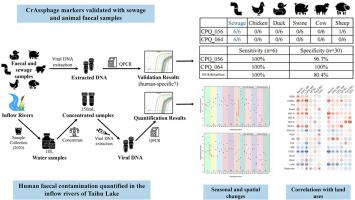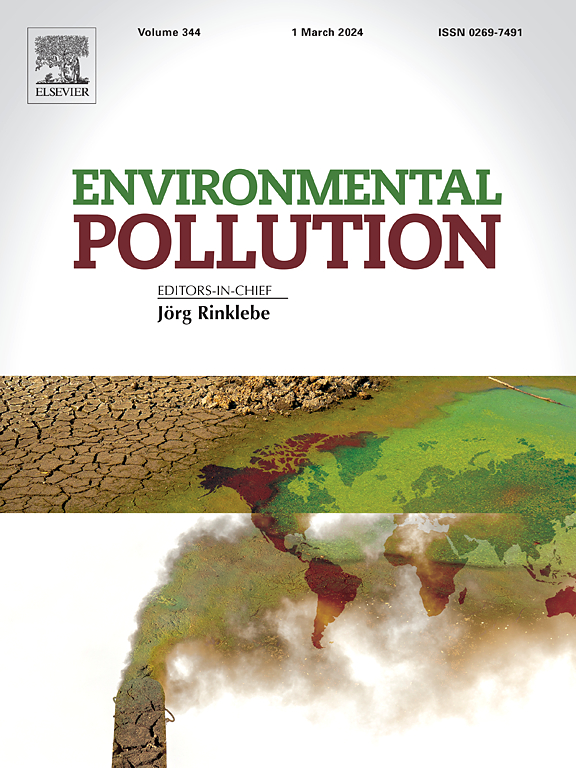验证 CrAssphage 微生物源追踪标记并与类杆菌标记进行比较,以检测和量化地表水中的粪便污染物
IF 7.6
2区 环境科学与生态学
Q1 ENVIRONMENTAL SCIENCES
引用次数: 0
摘要
人类特有的粪便污染一直影响着地表水,由于其可能与病原体同时存在,因此对环境和公众健康都构成了威胁。我们利用针对细菌和病毒的微生物源追踪(MST)标记进行了扩展研究,以检测和量化粪便污染。2014年发现的原型crAssphage是一种推测为感染巴氏杆菌的噬菌体,在未经处理的污水中显示出卓越的人类特异性和高丰度。本研究评估了crAssphage标记物CPQ_056和CPQ_064作为微生物源追踪(MST)工具检测中国地表水中生活污水污染的适用性。基于生活污水和动物粪便样本的验证测试表明,在本研究范围内,CPQ_056 和 CPQ_064 的灵敏度/特异度分别为 100%/96.7%和 100%/100%,超过了 HF183 等传统类杆菌标记物(针对污水的灵敏度/特异度分别为 100%/80.4%)。在 2020 年夏季和冬季采集的入湖河流水样中,对针对不同宿主并在太湖流域得到验证的 MST 标记(CPQ_056、CPQ_064、BacUni、HF183 TaqMan、Pig-2-Bac 和 GFD)进行了定量分析。结果表明,污水废水是所有粪便污染的主要污染源。空间分析表明,受人类活动影响最大的西北部河流污染程度较高。一些河流的下游还出现了稀释模式。与水质参数的相关性表明,营养相关污染和粪便污染同时存在,尤其是在工业区、低密度住宅区、绿地和市政服务区。研究结果表明,crAssphage 标记能有效提高粪便污染监测的精确度和准确性,为政策制定者和环境管理者提供了宝贵的工具。本文章由计算机程序翻译,如有差异,请以英文原文为准。


Validation of crAssphage microbial source tracking markers and comparison with Bacteroidales markers for detection and quantification of faecal contaminations in surface water
Human-specific faecal contamination has been affecting surface water and is a threat to both the environment and public health due to its potential co-occurrence with pathogens. Extended studies were conducted to detect and quantify faecal contamination using microbial source tracking (MST) markers targeting bacteria and viruses. The prototypical crAssphage, a presumed Bacteroides-infecting phage discovered in 2014, showed superior specificity to human faeces and high abundance in untreated sewage water. This study evaluated the applicability of crAssphage markers, CPQ_056 and CPQ_064, as MST tools for detecting domestic sewage contamination in surface water in China. Validation tests based on domestic sewage and animal faecal samples demonstrated high sensitivity/specificity of 100%/96.7% for CPQ_056 and 100%/100% for CPQ_064 within the scope of this study, surpassing the performance of traditional Bacteroidales markers such as HF183 (100%/80.4% against sewage). MST markers targeting different hosts and validated in the Taihu watershed (CPQ_056, CPQ_064, BacUni, HF183 TaqMan, Pig-2-Bac, and GFD) were quantified in water samples collected from the inflow rivers of Taihu Lake in summer and winter 2020. The results showed the dominance of sewage/wastewater as the source of contamination in all faecal pollution. Spatial analysis revealed higher contamination levels in northwest rivers, which were those most impacted by human activities. There was also a diluting pattern downstream of some rivers. Correlations with water quality parameters indicated the co-occurrence of nutrient-related pollution and faecal contamination, particularly in areas with industrial, low-density residential, green space, and municipal service land uses. The findings established the efficacy of crAssphage markers in enhancing precision and accuracy in monitoring faecal contamination, offering valuable tools for policymakers and environmental managers.
求助全文
通过发布文献求助,成功后即可免费获取论文全文。
去求助
来源期刊

Environmental Pollution
环境科学-环境科学
CiteScore
16.00
自引率
6.70%
发文量
2082
审稿时长
2.9 months
期刊介绍:
Environmental Pollution is an international peer-reviewed journal that publishes high-quality research papers and review articles covering all aspects of environmental pollution and its impacts on ecosystems and human health.
Subject areas include, but are not limited to:
• Sources and occurrences of pollutants that are clearly defined and measured in environmental compartments, food and food-related items, and human bodies;
• Interlinks between contaminant exposure and biological, ecological, and human health effects, including those of climate change;
• Contaminants of emerging concerns (including but not limited to antibiotic resistant microorganisms or genes, microplastics/nanoplastics, electronic wastes, light, and noise) and/or their biological, ecological, or human health effects;
• Laboratory and field studies on the remediation/mitigation of environmental pollution via new techniques and with clear links to biological, ecological, or human health effects;
• Modeling of pollution processes, patterns, or trends that is of clear environmental and/or human health interest;
• New techniques that measure and examine environmental occurrences, transport, behavior, and effects of pollutants within the environment or the laboratory, provided that they can be clearly used to address problems within regional or global environmental compartments.
 求助内容:
求助内容: 应助结果提醒方式:
应助结果提醒方式:


